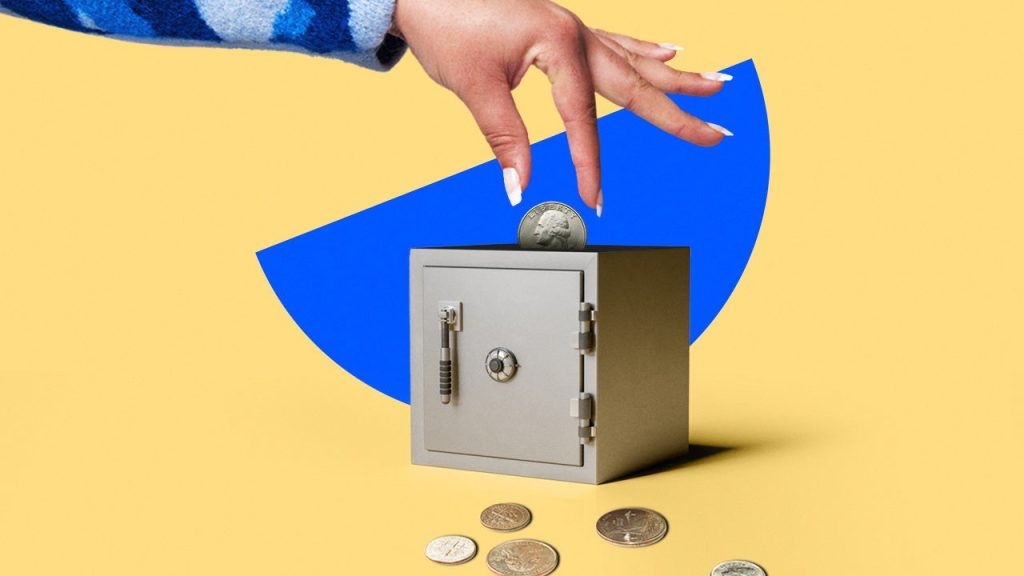Images by Getty Images; Illustration by Issiah Davis/Bankrate
The average savings account rate is a benchmark for the overall interest-rate environment, but it’s not a rate you should settle for.
Rather, aim for an annual percentage yield (APY) many times the national average, such as those offered by high-yield savings accounts. It’s easy to find a high-yield savings account that offers a competitive return with a no or low minimum balance requirement.
National average savings account interest rates
Many online banks have savings interest rates higher than the national average savings account interest rates. The higher the rate, the more interest you’ll earn on your savings. The national average savings account yield is 0.59 percent APY, according to Bankrate’s survey of institutions as of Sept. 30.
How Bankrate calculates the national average
In June 2023, Bankrate updated its methodology that determines the national average savings account rates. Bankrate surveys more than 500 banks and credit unions weekly to generate the national averages. Included in the survey are institutions that are broadly available and offer high yields, as well as some of the nation’s largest banks.
APY comparison
| Financial institution | APY | Minimum opening balance | Learn more |
|---|---|---|---|
| Note: Annual percentage yields (APYs) shown are as of Oct. 3. Bankrate’s editorial team updates this information weekly. APYs may have changed since they were last updated and may vary by region for some products. | |||
| UFB Direct | 4.83% | $0 | Read review |
| Bread Financial | 4.95% | $100 | Read review |
| Bask Bank | 4.85% | $0 | Read review |
| TAB Bank | 4.52% | $0 | Read review |
| LendingClub Bank | 4.80% | $0 | Read review |
| Synchrony Bank | 4.30% | $0 | Read review |
| Marcus by Goldman Sachs | 4.25% | $0 | Read review |
| Capital One | 4.10% | $0 | Read review |
| Discover Bank | 4.10% | $0 | Read review |
| Ally Bank | 4.00% | $0 | Read review |
| TD Bank | 0.02% | $0 | Read review |
| Chase | 0.01% | $0 | Read review |
| U.S. Bank | 0.02% | $25 | Read review |
| Wells Fargo | 0.01% | $25 | Read review |
| Bank of America | 0.01% | $100 | Read review |
Interest rates for linked checking and savings
Linking your savings account with a checking account is one way to earn a higher yield at some banks. Sometimes called relationship rates, it’s more common for brick-and-mortar banks to offer them.
For instance, at Huntington Bank, a higher APY is offered to customers who pair a savings account with a checking account:
- Standard savings account yield: 0.01% APY
- Savings account yield when paired with a Huntington Perks Checking or Huntington Platinum Perks Checking account: 0.02% APY
To avoid a $25 monthly maintenance fee, however, the Huntington Platinum Perks Checking account requires $25,000 in total relationship balances.
The combination of large amounts of money to avoid monthly fees and lower APYs from brick-and-mortar banks are why online banks are often a better choice for those looking to find the highest APY. Online banks tend to offer higher savings account interest rates — including a higher APY across all balances, but some require a minimum balance to earn it. The majority of online banks have minimum opening requirements of $100 or less.
| Bank | Checking account/Savings account combo | Standard savings yield | Yield with relationship | Minimum balance to avoid monthly checking account fee |
|---|---|---|---|---|
| Huntington Bank | Huntington Perks Checking or Huntington Platinum Perks Checking/Huntington Relationship Savings | 0.01% APY | 0.02% APY* | Total relationship balance of $25,000 required. |
| Chase | Chase Premier Plus Checking or Chase Sapphire Checking/Chase Premier Savings | 0.01% APY | 0.02% APY** | Average beginning day balance of $15,000 in this account and linked qualifying deposits/investments or or by meeting other qualifications*** |
| U.S. Bank | Bank Smartly Checking or Safe Debit account | 0.02% APY | 4.10% APY**** | Total relationship balance of $25,000 required. |
* With a Huntington Perks Checking account or a Huntington Platinum Perks Checking account.
** Besides linking a Premier Plus and a Chase Sapphire Checking account with a Chase Premier Savings account, you also need to make at least five transactions — that you initiate — with that linked checking account during the monthly statement cycle.
***A linked qualifying Chase first mortgage enrolled in automatic payments from your Chase account can also waive the monthly fee on the Chase Premier Plus Checking account. Fee is also waived for current service members and veterans of the U.S. Armed Forces with a qualifying military ID.
**** A balance of at least $25,000 is required in addition to a linked checking account.
Bottom line
Compare online banks with larger banks when you search for a high-yield account. You’re likely to find that online banks have lower minimum balances, won’t have monthly fees and may pay the same APY on all balances. In many cases, these savings account interest rates, and the corresponding APYs, will be higher than what you’ll earn from a savings account at a brick-and-mortar bank.
Use the national average savings rate as your gauge. You should be able to easily find a bank that’s offering an APY multiple times higher than the national average.
Calculate the difference between the APY at a big bank compared with the yield at an online bank to see what higher-interest earnings look like. The power of compounding helps your interest earn interest over time.
Read the full article here

